Most people don't experience pain directly related to their food. Yet when I was at my worst, every meal I ate caused me some level of pain either immediately or within an hour or two of finishing. In kind, I started to eat more slowly and eat less variety, even cutting down to no longer consuming dishes but merely ingredients.
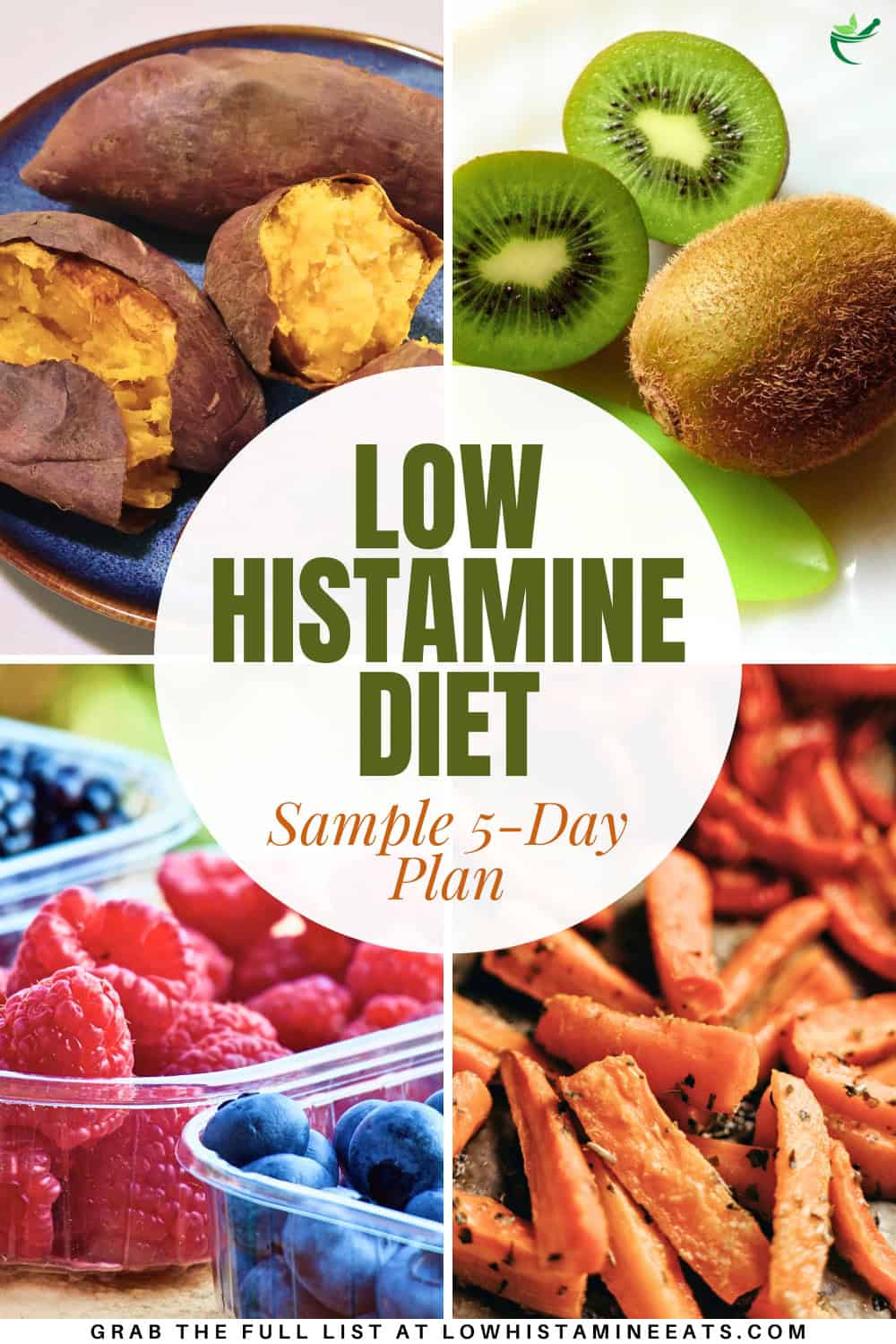
One day in early May, a friend introduced me to the relatively unknown mast cell activation disorder, and that very night I deep-dove into her diet, going cold turkey on most everything I enjoyed within three days of realizing I probably have histamine intolerance.
Before we begin, I want to make sure you're armed with more resources than I was. It's important to understand the basics of low histamine diet plans and why they seem so specific and restrictive. Any good elimination diet meal plan will outline the foods you can and should have (see below), but it will also explain why to avoid the things that didn't make the cut (even if other low histamine recipes allow them).
Ideally, it will also emphasize antihistamine foods, as this plan does. In this case, all the foods off this list are either directly inflammatory or may stop your body from naturally calming inflammation.
Because that brain fog and acid reflux and hives and anxiety and stomach cramps? The allergy symptoms way outside of allergy season? Most of them may be caused by a histamine sensitivity often referred to as histamine intolerance, which you can start to treat by changing your diet.
Medical Disclaimer: as with everything on this site, this article is provided for information only. I strongly urge you to speak with your doctor or a licensed medical professional in order to assess whether or not you have histamine issues and/or issues with lectin, oxalates, salicylates, etc.
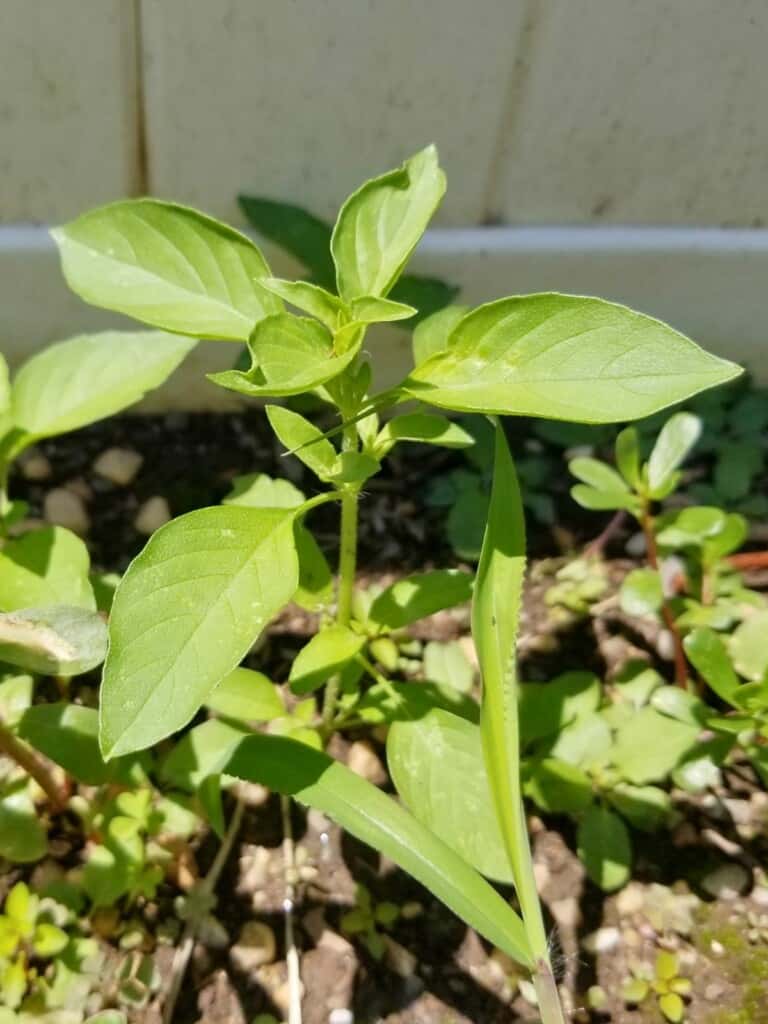
Jump to:
📝 Getting Started With A Low Histamine Diet
Overactive histamines are behind many people's mysterious and severe allergic reactions to seemingly innocuous foods (and even innocuous places), despite having no recorded allergy. But histamines are in everything, even the environment and especially your food.
However even beyond histamines, this sample mastocytosis diet is low fodmap and initially limits all foods which fall under relatively more common sensitivities like sulfites. This is because any such sensitivity has the likelihood of causing similar inflammatory reactions and symptoms.
To prepare for this antihistamine diet, I highly recommend preparing and freezing most of your meals ahead of time. While you could approach this diet slowly, taking out most of the worst offenders (like fermented foods & alcohol, and anything that's a histamine liberator) day by day, lots of people have issues with even the additives and flavorings in certain foods.
So if that's actually your main issue, a true low histamine diet would help you, but easing into the diet would offer little to no relief at all since there are additives in most things. Honestly, the list of foods you should take out would be way longer than the list below, and it would probably just make you as sad as it initially made me.
But just start off by eating two meals a day. Lessening the load on your gastric system is one of the keys to giving your body time to heal itself of the inflammation.
Especially if one of your problems is low stomach acid due to nutritional malabsorption, you'll need to either chew a lot more or eat softer, mostly broken-down foods. My approach could be described as conservative, but I've been through too much agony over the last few years to not take careful action (if I'm gonna take action at all).
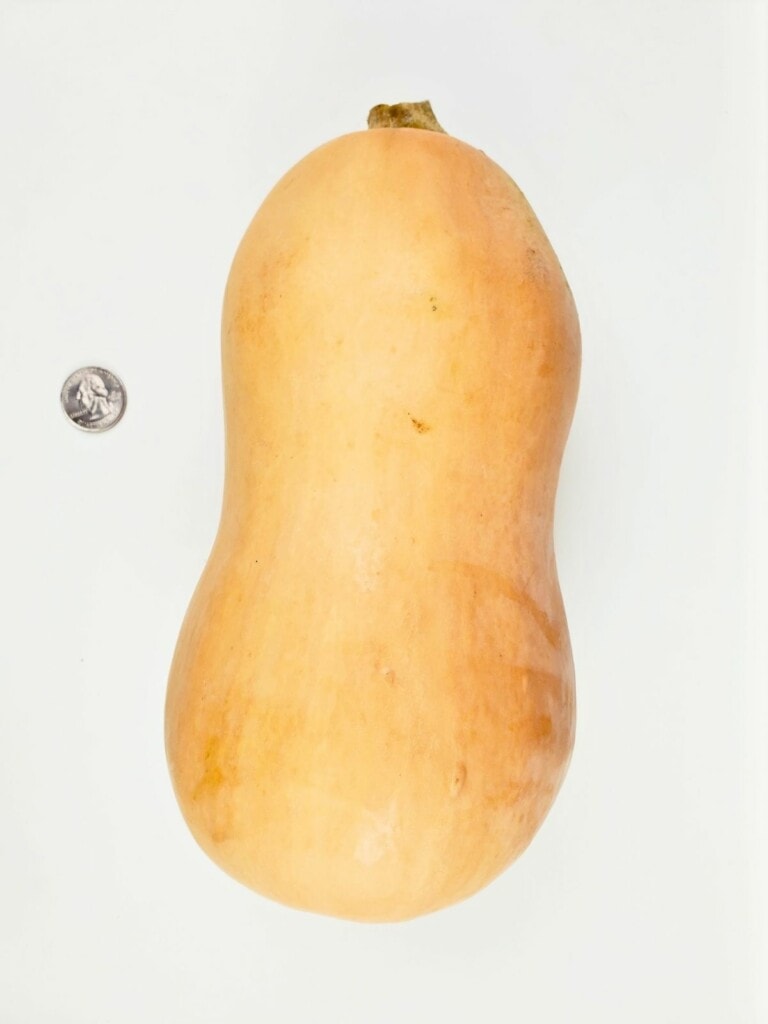
How I Came Up With The Safe Foods List
When I was first diving into research, most of the low histamine food lists I found had little overlap with each other, but I took what overlap I could find and wrote it out. Then I looked at a few other diet protocols— like FODMAP and AIP (Fermentable Oligosaccharides, Disaccharides, Monosaccharides, And Polyols and AutoImmune Protocol, respectively)— and I took out any no-no foods from those diets.
This was in case I was totally wrong with my self-diagnosis. Now with what I know, I've realized that generally these foods are off-diet because of a systemic reaction to one or more nutritional components in that food group, like nightshades, cruciferous vegetables, or dairy.
Most of the low histamine diet recipes out there will have one or more of these types of ingredients because they're packed with flavor and make great additions to dishes. But as I said, it's not important right now to understand the exact compound in any of these foods that you might react to.
Just suffice it to say that I've carefully kept all possibly reactive foods off this 5 day low histamine diet plan. If after 5 days you don't feel any better at all, you may still have a histamine issue, and I highly recommend sticking to the plan for another 5 days unless you for some reason feel worse on it.
If you have a will of steel and/or make it to the end of five days and just want to continue, try reintroducing the approved low histamine foods (see below) one day at a time, prepared using the existing approved ingredients.
To stretch this to ten days, on Days 6-10, simply repeat the same ingredients from Days 1-5, but adding in pasture-raised whole eggs and the italicized fruits & veggies from above on "Day 6".
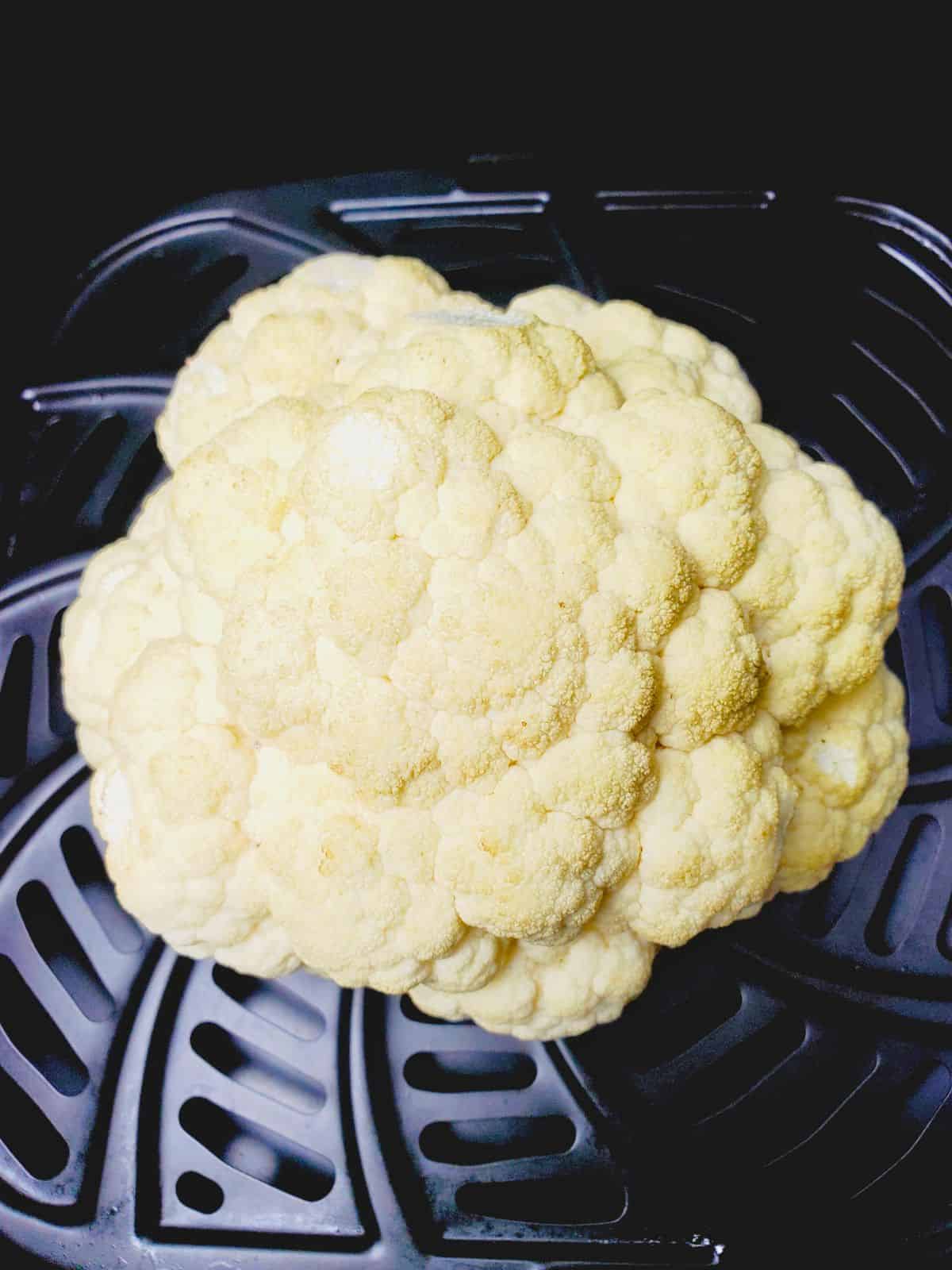
✅ Low Histamine Diet Safe Foods List
- Organic Flat Kale
- Organic Arugula
- Organic Carrots
- Organic Butternut Squash
- Organic Sweet Potatoes
- Organic Radish
- Organic Beets
- Organic Turnips
- *Organic Broccoli
- *Organic Brussels Sprouts
- *Organic Cauliflower
- *Organic Cabbage
- *Organic Garlic
- *Organic Onions
- Organic Blueberries
- *Organic Raspberries
- Organic Kiwis
- Organic Coconut Milk
- Organic Coconut Oil and Olive Oil
- Organic Chia and Flax Seeds
- Organic, Free-Range Chicken Breast
- Organic, Free-Range Pork (NOT bacon)
- Organic Chamomile Tea
- Sea Salt
- Fresh Organic Herbs: Ginger, Sage, Rosemary, Thyme, Basil, Lemongrass, Oregano, Turmeric, Bay Leaves, Saffron (note that basil can cause stomach upset in very rare cases, with emphasis upon very rare)
*should be avoided for first 3 days of low histamine diet plan, and after that may be used to replace any other meal, when prepared using the above ingredients
Note: Some people also have issues with lectins, salicylates, and/or lectins, among other plant chemicals. If you find you're still having issues after 5 days following this plan, but have seen some improvement, consider talking to your doctor about a co-sensitivity.

What to Meal Prep (Buy Ahead)
You probably have a lot of these ingredients already at home, but make sure that all of those versions are both fresh and organic (though pure dried versions of the herbs & spices are usually fine). You'll note that these meals are very repetitive, which is on purpose— the easiest way to approach low histamine meals is to prep your food ahead of time and forget about it, at least for a little while (i.e. until you feel better).
If you tend to have a hungry tummy, make one extra serving of each dish to put in a separate container to prevent temptation to stray off-diet. For these few days, if you're still hungry after a meal, add another couple ounces of meat per meal or another two tablespoons of oil or coconut cream. Upping your protein in each meal will help you feel fuller longer and pace how quickly the calories hit your system.
You can also have a cup of ginger tea or chamomile tea any time, except for the last couple of hours before bed (this is in an effort to lower the volume of stuff in your stomach before you lay down to bed). You'll be able to explore more creative low histamine recipes after your first couple weeks.
- 3 medium sweet potatoes
- 2-14oz. cans coconut milk or coconut cream
- coconut oil
- olive oil
- sea salt
- 28oz/1.75lbs. chicken breast
- 4oz basil (pureed with olive oil to make a plain sauce)
- 2"/2 teaspoons chopped fresh ginger
- 2 teaspoons chopped fresh or flash-frozen lemongrass
- 1 lb. organic carrots
- 1 bunch of flat-leaf kale
- 1 large butternut squash
- 6-8oz/0.5lbs. pork loin or tenderloin
- 2 pints blueberries
- 1 pint raspberries
- 1-4 kiwis
- fresh oregano, rosemary, thyme, and sage leaves
- optional: chia seeds
Note: Make sure you get enough calories, even for the short period you follow this diet. Scale this recipe to your usual appetite, and add in more olive oil or coconut oil to your next meal, if you find yourself still hungry.
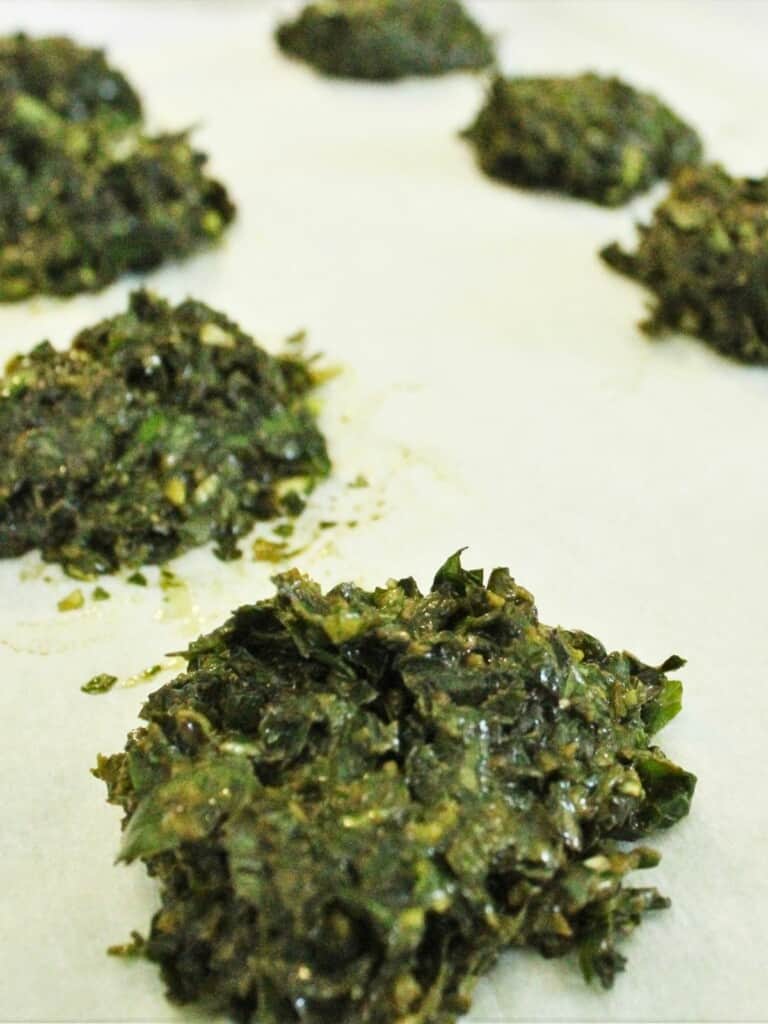
Low Histamine Diet Day 1
Breakfast/Lunch: smashed sweet potato and basil chicken.
Drink two huge glasses of water as soon as you wake up, then begin making breakfast: one medium sweet potato, sliced & drizzled with 1 tablespoon coconut oil and a sprinkle of sea salt, then roasted 425°F/220°C for 40-50 minutes. If you're feeling fancy, smash the freshly-roasted potato with a fork and top it with some coconut cream & chia seeds until it's more smooth.
For the basil chicken, bake 110g/4oz chicken breast rubbed with 1 Tablespoon olive oil at 350°F/175°C for 20 minutes. Top with 2 tablespoons of basil sauce (just basil + olive oil) and bake for 5-10 minutes, until internal temperature reaches 165°F. Salt to taste.
Snack/Dessert: ½ cup fresh blueberries with 2 tablespoons coconut cream or coconut milk.
Dinner: Charred chopped kale (optional ginger) with a dollop of coconut milk on top, and 4oz lemongrass chicken breast. To char the kale, simply wash, dry, and de-spine two leaves of kale with a knife. Warm the torn leaves on a nonstick pan over medium heat for about two minutes, until totally dry and wilted.
Add 1 teaspoon of olive oil and ⅛ teaspoon of fresh ginger or a dash of ginger powder. Cook for 5-7 more minutes, stirring more frequently as it cooks, and salt to taste & serve. Lemongrass chicken is a slight flavor upgrade to plain chicken.
Cut your chicken into small pieces, no larger than an inch, and heat it in 2 Tablespoons of olive oil over medium heat. Once the oil starts sizzling, turn heat down to medium-low and add ½ teaspoon of fresh ground ginger, ½ teaspoon of turmeric, and 1 Tablespoon of chopped lemongrass (just the roots).
Cook for 5-7 more minutes, stirring occasionally, until largest piece shows no pink in the middle and some pieces begin to brown. Add a dollop of coconut cream, and then salt & pepper to taste.
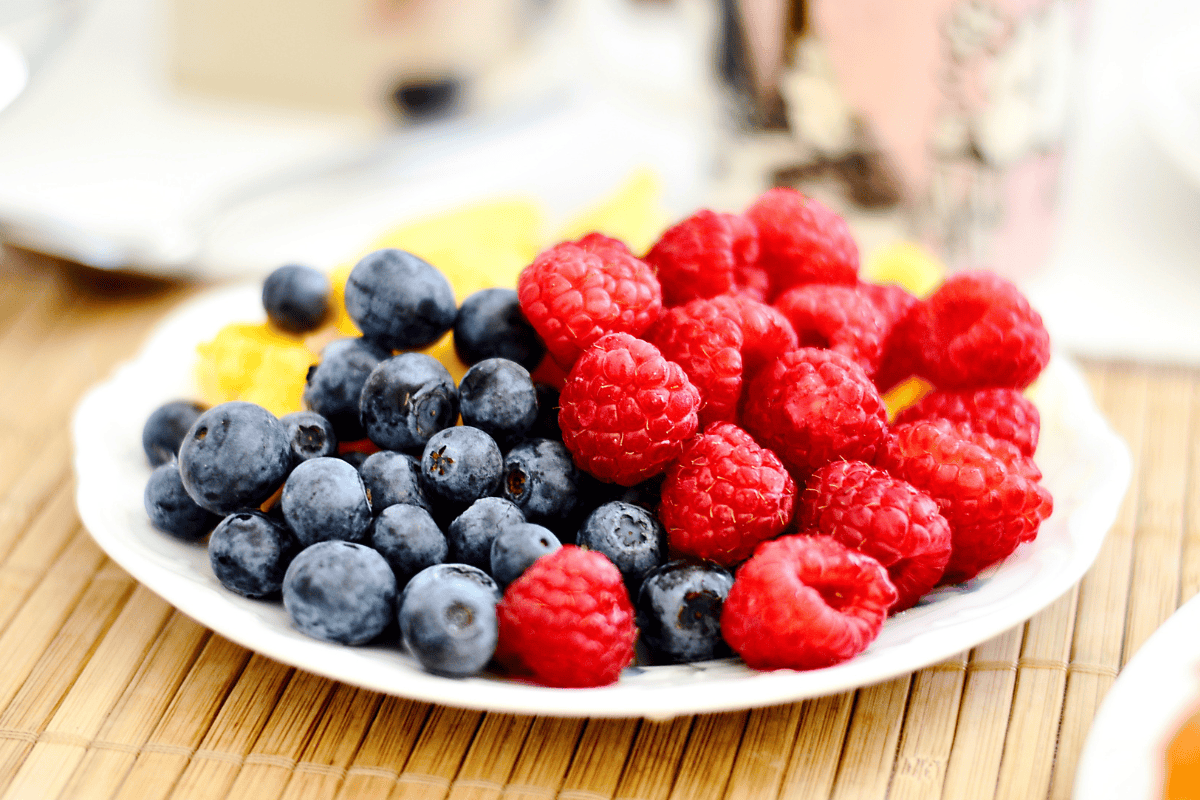
Low Histamine Diet Day 2
Breakfast/Lunch: rosemary roasted carrots with 2oz of chopped chicken salad.
Drink two huge glasses of water as soon as you wake up, then begin making breakfast. Peel one large or two small carrots, then chop them into small pieces. Toss the carrots onto a nonstick pan over lop heat and let them slowly cook for five minutes, stirring occasionally. Add 1 Tablespoon of olive oil and ½ teaspoon chopped dried rosemary or ¼ teaspoon chopped fresh rosemary.
For the chicken, take a 2-3oz piece and cut it into smaller pieces. Cook those smaller pieces in 1 Tablespoon of olive oil for a few minutes, until no piece shows visible pink. Let it cool for a couple minutes, then take that chicken and chop it into thin pieces and add it back to the pan.
Pour in another Tablespoon of olive oil along with ¼ teaspoon each of fresh sage, rosemary and oregano plus ⅛ teaspoon fresh thyme, and turn the heat up to medium high to warm the herbs and brown the chopped chicken. Serve chicken alongside the rosemary carrots, and salt to taste.
Snack/Dessert: 1-2 fresh kiwi fruits.
Dinner: 4-6oz. roasted butternut squash and 3-4oz roasted pork cooked with olive oil and sea salt (ginger optional, but recommended). Peel your squash and cut it into medium-sized cubes. Take your pork loin or tenderloin and cut it into pieces slightly larger than the squash.
Toss everything in 2 Tablespoons of olive oil and ⅛ teaspoon of salt (this is also when to add ½ teaspoon of fresh ginger or a ¾ teaspoon of ginger powder, if using).
Bake the squash and pork together on a baking sheet at 400°F/205°C for 25-30 minutes, flipping the pieces after 15 minutes to prevent burning. Once the pork is done (generally no longer pink in the middle), the dish is done. Eat or freeze almost immediately.
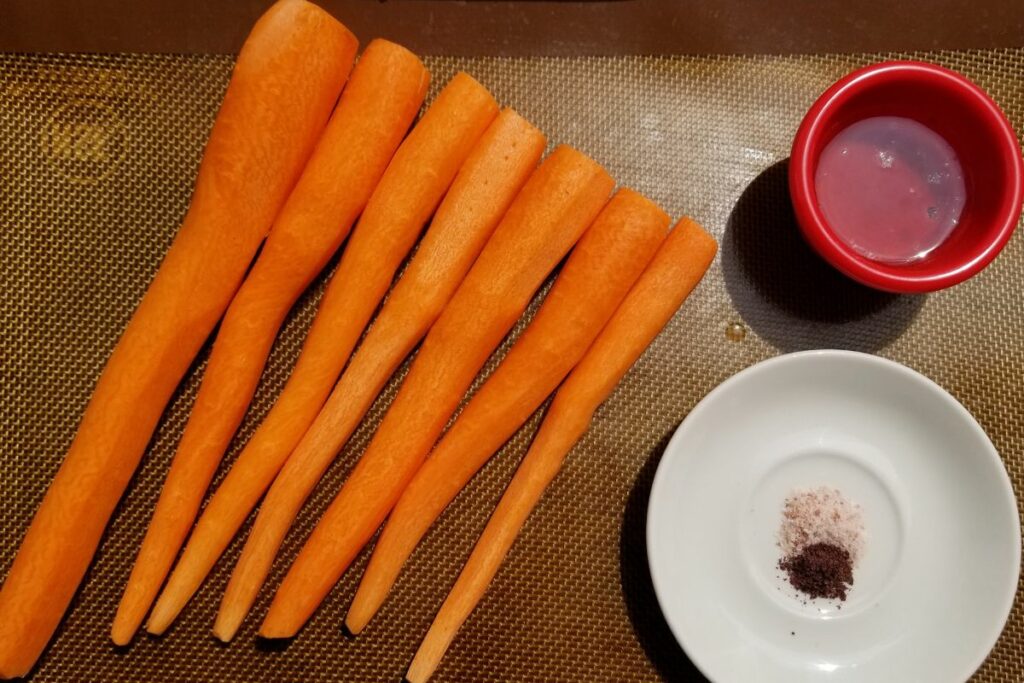
Low Histamine Diet Day 3
Same as Day 1.
Low Histamine Diet Day 4
Same as Day 2. This is where you can start adding in some of the sulfurous (but incredibly healthy) or otherwise potentially-triggering foods italicized above. If you feel at all more triggered by adding in any of the foods, go back to the pre-approved dishes above and only add in one new ingredient each day. This whole diet is to get an idea of what may be causing all your symptoms.
Low Histamine Diet Day 5
You can choose to make extras of either low histamine breakfast and/or dinner combo you want; same goes for dessert. I recommend just doing Day 1 over again here, but it's up to you, as each and every one of these foods should have no reaction if you have histamine intolerance, and it should start to ease your symptoms pretty immediately.
If you're feeling great and haven't reacted to anything so far, you may be getting restless. For those feeling ready to dive into some more creative (very) low histamine recipes, you can check out my Level 0 Histamine Recipes.
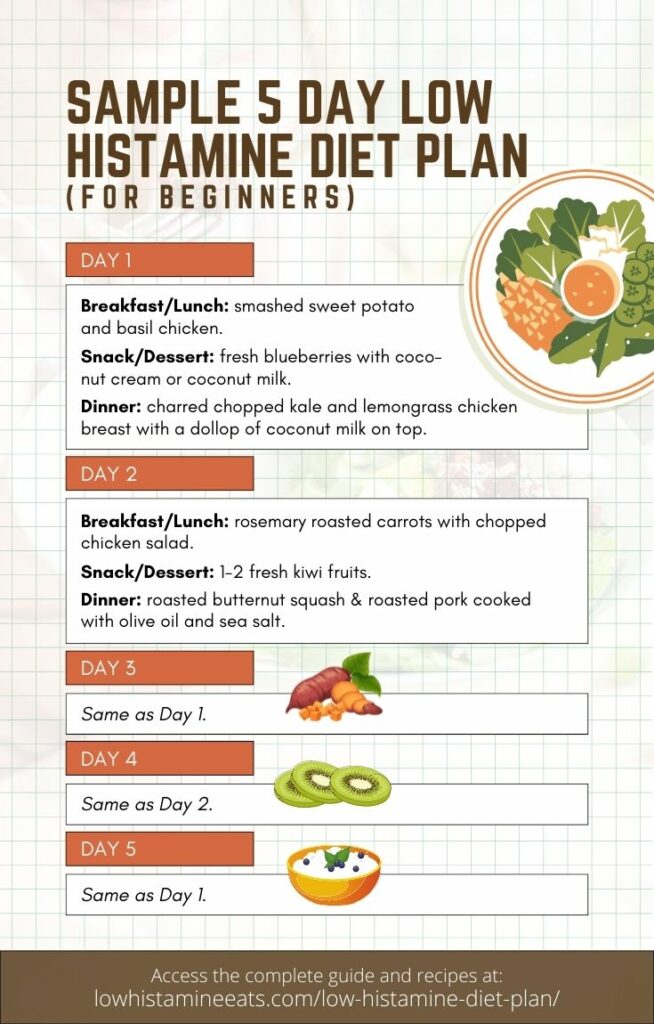
💡 Tips For Sticking to the Low Histamine Diet
This mast cell diet is an incredibly healthy one to follow as a general rule (in the short term only), but I understand that it's not always the easiest. Just take it one low histamine meal at a time. I've compiled more tips in this post, but if you're already feeling overwhelmed, the ones below will get you started.
Just make sure you set yourself up for success by making your home amenable to this change, otherwise you may find it harder than necessary to make it through five days! And take it from me— any off-diet food can bring about a reaction. If you really want to follow a diet to see if you have histamine intolerance, then you need to limit your intake of all high histamine foods. Here are my tips:
- Have remedies (natural antihistamines and anti-inflammatory foods) on hand in case of a reaction. It's okay to still be having a bad reaction and a bad day; that doesn't mean the diet isn't working. It's okay to still need an antihistamine on Day 3, as your body won't recover from the inflammation overnight.
- Keep all your high histamine food as out of sight as possible, and keep the low histamine foods in your fridge & freezer as close to eye level as possible. Somewhere on the outside of your fridge and pantry, right at eye level, keep a notecard with the list of meals you're going to be eating that day. Distract yourself from thinking about food during this time, and do as much meal prep as you can ahead of time. Try keeping a diary of any ongoing HIT symptoms throughout the diet, for later adjustments.
- I totally get that food is life: keep ALL food on one shelf in the freezer and then one shelf in the fridge so that you're not even tempted to look elsewhere for something. See the low histamine meal ideas above for a shopping list.
- Remember the importance of freezing any prepared foods and keeping veggies as fresh as possible when you're buying the food from the list above. And please please please buy organic, as the histamine level is generally lower!!
- This one is kind of out there, but if you find that you have some blockage, supplemental fiber may be your friend. I highly recommend using 1 teaspoon of psyllium husk in 8oz. of water if you start to experience any tummy upset. 2 teaspoons of flax meal in 8oz. of water could serve the same purpose, but if it seems to make your stomach upset worse, stop immediately.
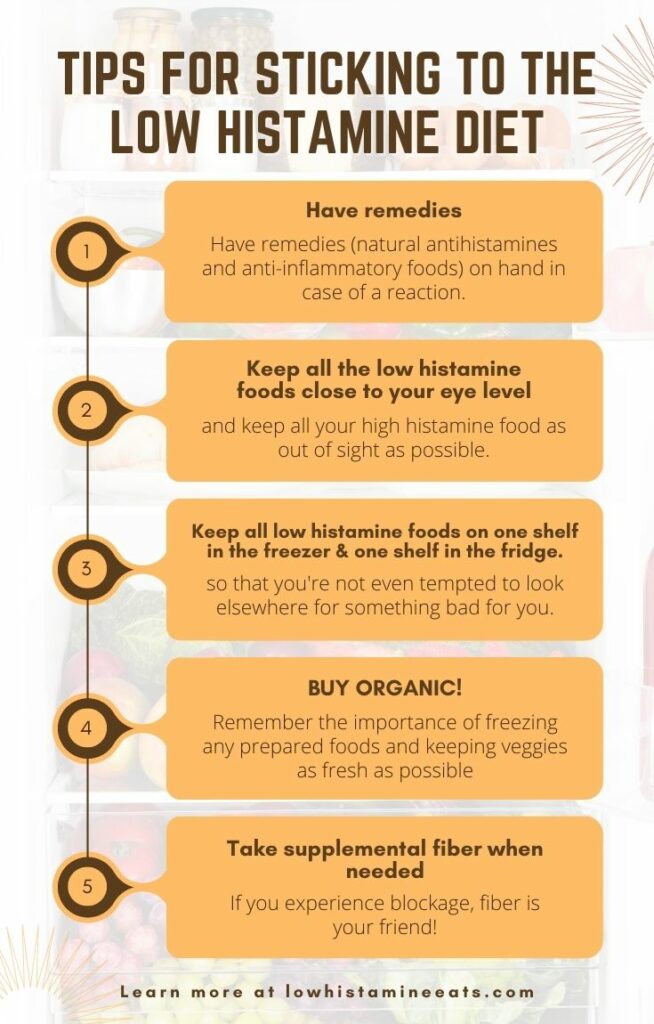
If this low histamine diet plan helped you sort out your own approach to histamine intolerance, please let me know in the comments!
Save this post for later!

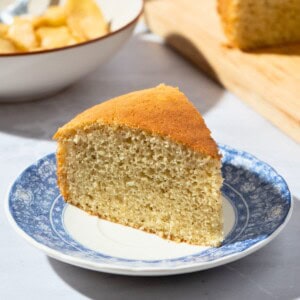











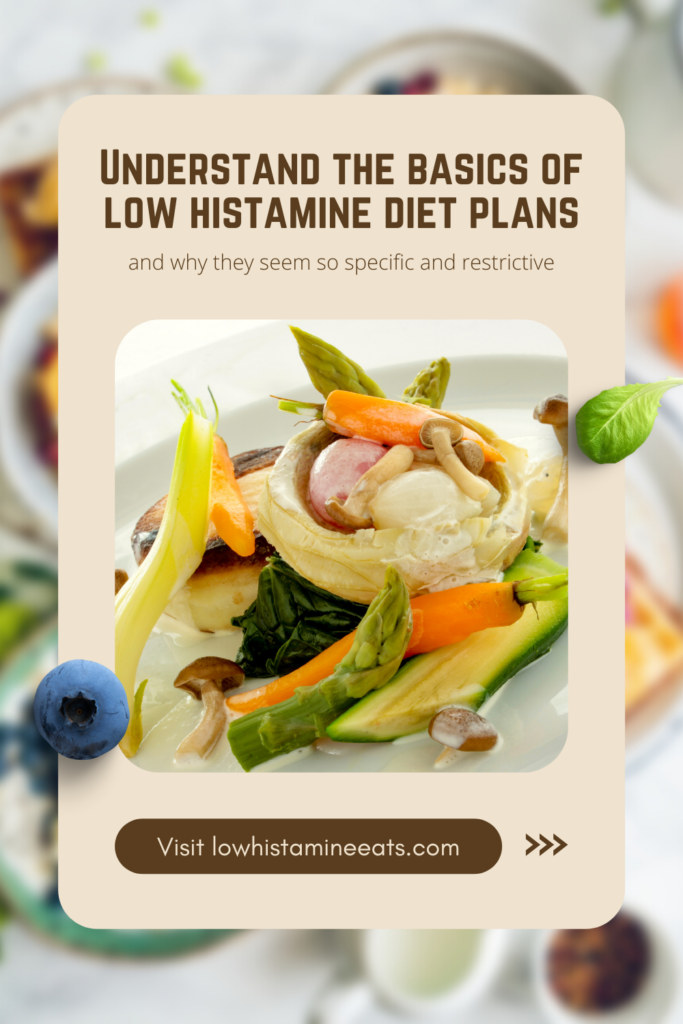

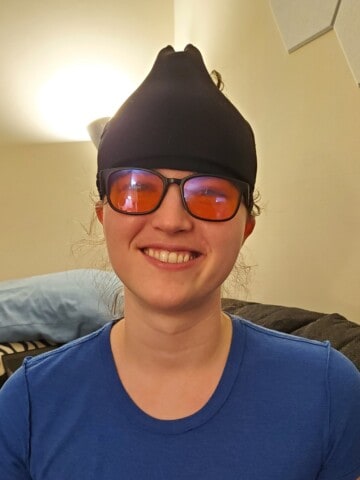
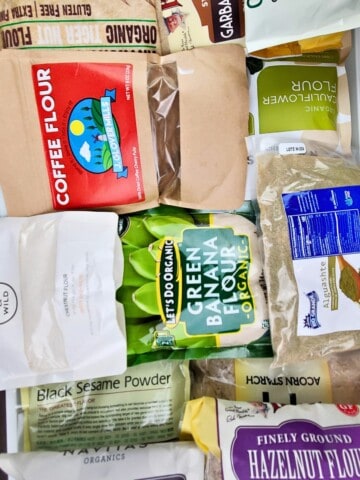

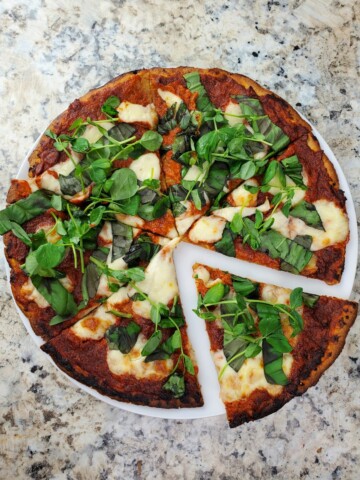
Miriam says
Very interesting and useful article. What would you recommend in place of the meat and poultry for someone who is vegan? Thanks
Max says
I'll be honest-- I've been getting that question for years now, and I have yet to come up with a universally effective answer. This is because soy protein can be inflammatory for some people (unpredictably so), which knocks out the usual of tofu. Green peas are iffy at best, which knocks out pea protein, and all other nuts, legumes, seeds, and grains should also be avoided during the first couple weeks, due to potentially-inflammatory antinutrient content. I suggest you read more about the potential issues you can still have with plant proteins in my articles on protein powders and on nuts & seeds, so you can read about vegan low histamine protein sources and decide where to start. I don't want you to have to eat meat if you'd prefer not to, so I wish I had an easier & more universal answer, but I hope this helps.
josephine says
Thank you for a detailed article, the recipes are really helpful. sending healing your way and my way too!!!!
Max says
Thanks, Josephine! <3
Cath says
Thank you for your article. I'm feeling ready to start!
lowhistamineeats says
That's great! You're very welcome!!
Lizet Lynch says
Thank You for all your time put into this crucial information.
lowhistamineeats says
It's my pleasure! I'm just glad to have some more easily-digestible info out there (pun intended!).
Maya says
Hey, thank you so much for this site, it's so hard to find a reliable and scientifically rigorous source of info on all things histamine!
I suffer from histamine intolerance, in addition to my previously diagnosed Hashimoto's, Sjögren's Syndrome, IBS and several food allergies, so navigating food is a major headache..
Have started your LH diet plan, but needed to restrict the list of foods even more (most fruit wreck havoc with my IBS, kiwi gives me a lot of pain, can't have any cruciferous veg or nightshades, allergic to alliums, blahblahblah). My bloating has gone down considerably and sort of moved down towards my lower abdomen if it makes any sense, but I'm still in low to moderate pain/discomfort after eating anything plus am still getting heartburn after every meal. In your experience, should I wait it out and if so how long for (it does seem to be getting better, just very slowly) or should I eliminate more foods?
Another question, why aren't non-gluten grains like millet or oats allowed in the first week?
Thanks again, your work is not going unnoticed 🙂
lowhistamineeats says
Thank you, Maya! I'm glad to have offered some guidance-- I thought the same when I first started a low histamine diet, hence, starting my own! I can imagine that food is a big pain point, of course, with so many directions/restrictions to follow. I'm sorry you had to cut the list even further, but I actually left out other grains form the start with people like you in mind. Grains, legumes, nuts, and seeds all contain a cacophony of plant chemicals which can be tough on your stomach and cause or worsen inflammation in vulnerable people (i.e. those who are already very inflamed).
I linked my nuts & seeds guide here because it goes in-depth into the 4-5 main toxins that could irritate your stomach, but the fist is that trying to introduce fattier seeds and nuts could be more tolerable since they have fewer potential triggers. I'm not a doctor, and I highly suggest you work with a nutritionist on sorting out a more personalized diet, but it sounds to me like you may also have some SIBO (and getting rid of it should at least lessen your symptoms). I'm currently on week 5 of a protocol to kill off more opportunistic bacteria that my docs want to blame for my continued IBS, and I hope it helps, but I know stress/anxiety also plays a huge role for me.
I'm glad you're feeling better, but heartburn is certainly still a problem-- have you checked to see if you have low or high stomach acid? I have low stomach acid still, so I take stomach acid + gentian root with every meal. You can do the baking soda stomach acid test; lots of tutorials out there ig you google it. And I'm assuming with all your diagnoses that your docs are on top of if you're low in anything (like copper, iron, B12, etc.) that are cofactors for DAO and for stomach acid production, but that's another avenue to look down. My final thought is that you may indeed be sensitive to one or more of the plant toxins-- have you ever tried eating only carnivore for 1-2 days? This is a bit more out there, but also something to bring up with your doc, though certainly check the other two first, because an all-meat diet + low stomach acid would be torture! I'm so sorry you're contending with all this, but I really hope this info helps!
Deb says
is there any safe fish? What about seeds - Hemp, Sesame, Pumpkin?
lowhistamineeats says
Fresh-frozen salmon is generally okay, but I'd avoid fish altogether for the first month of a low histamine diet, as they're the source of the original histamine intolerance, known as "scombroid poisoning." As for seeds, all of those should be okay because they're low histamine, but they do also contain other amines that can cause some people to react. If you've reacted to nuts or seeds in the past, I'd wait a few weeks before trying to reintroduce them.
I didn't include either of those here for the above reasons, but they are still low histamine. 🙂
Belinda says
As a non-meat eater what do you recommend instead of pork and chicken in these recipes please?
lowhistamineeats says
Belinda, I've had a vegan version of this meal plan half-done for nearly a year, but I just have not yet found a MCAS-safe protein option that's not meat. However, the main reason that these plant-based alternatives are not allowed during the elimination phase is because of the "plant poisons" in them that can further irritate an already inflamed stomach. These include things like oxalates, phytic acid, lectins, and salicylates. If you feel strong enough right now, ask your doctor about doing a juice fast (or water fast) for 24 hours, then the next day try adding in some low histamine nuts along with some berries or other antihistamine foods from the plan here, and monitor your reaction. Try just organic almonds and pecans on that first day, for example, but from then on don't add in more than 1 food every day or two (otherwise it can be hard to tell what foods your body can't currently handle). Please keep in mind that I'm not a doctor, and I highly recommend you speak to your about this, but most likely they'll agree that an elimination of most all foods for 24-48 hours will be a decent enough restart to gauge which plant proteins may give you the most trouble (& the least).
Catherine says
Hi!
I have been following your 5 day meal plan with overall very good results. However I seem to be having some side effects from Basil, not even Holy Basil, but regular Basil. And on looking around it seems Basil can cause lower blood pressure, and some stomach upset. This is not a criticism, because I am a retired MD and I didn’t know this. Just thought I would let you know. It is difficult to predict individual sensitivities, as you know. I know more about myself and I still appreciate the work you have put into this blog and have found the recipes and lists quite helpful. No more than a light sprinkle of Basil for me from now on!
lowhistamineeats says
Oh goodness! I'm so sorry you've had some stomach upset, Catherine. I'll amend the post to mention that, as I also hadn't heard of someone having a negative reaction to basil. It certainly is difficult, daresay I impossible, to predict individual sensitivities! I'm glad you've found the site helpful, and I hope you can incorporate some other antihistamine herbs into your diet moving forward. Good luck with the rest of your elimination phase!
Karlin says
Thank you so much for this!
I think you might have left off carrots from your shopping list.
I am looking forward to trying this myself starting tomorrow morning.
lowhistamineeats says
You are totally right, Karlin! I can't believe I missed that, but it's been fixed. Thank you for pointing it out, and I hope trying the LH diet gives you some answers!
FJ says
Hello, thank you so much for all your information.
I am trying to determine whether my symptoms are being caused by HIT.
I would like to try your 5 day diet plan - is there a way to safely pre-prepare and precook the food? Thanks, FJ
lowhistamineeats says
You're very welcome, FJ! Yes, you can actually pre-cook and prepare all five days worth of food and freeze them in individual containers for each meal, as everything is very freezer-friendly in terms of flavor and texture. Good luck with everything; it's 100% worth trying the diet for a few days to at the very least rule it out!
Lott says
Hi there!
Would you know what's the maximum number of days that we can safely do this diet? I'm wondering if we can follow it for over 10 days, in case we don't feel any significant improvement in symptoms.
Thanks so much for posting the food list, I'm sure it's helping a lot of people. 🙂
lowhistamineeats says
Hi, Lott! I'm not a medical professional, and if you suspect you may have a histamine intolerance you should work with your doctor on the best steps to take for an official diagnosis. But that said, I followed this diet for 2 weeks at the very beginning of my journey, so about three rounds of meals in this exact fashion, but I was feeling relief form symptoms within a couple of days. I'd say that if you feel zero relief after two rounds, you should consider that 1) you may have extraneous food allergies to one or more of these foods; or 2) you may have an issue with another biogenic amine, such as tyramine, or with a plant compound such as salicylates or oxalates or lectins.
It also may not be histamine-related in the least, and may be more connected to a specific food allergy or SIBO or intestinal permeability, but without testing for any of those, you can't be sure. But my best advice in such a case is to keep a detailed food diary of what you eat, and then how you feel throughout the day, improvement or not. I hope this helps, and yes, I hope that the foods list has been helping others, as well! 💗
Mary says
I'm loving your site and all the information it provides. Thank you for being so generous with all of it. I suspect I have HIT or MCAS, but like others, can't find a dr to take me seriously. But they expect us to try whatever prescription drugs might work some magic. Ive tried 4 in the last few months and they made everything worse. So this is worth a try and your site is helping me with my new fear of potential food triggers.
lowhistamineeats says
I'm so sorry you're struggling, Mary— I'm no stranger to developing a fear of your food, and a strong resentment of the medical community along with it. Not listening to your patients when they come back with the same issues over & over or have bad reactions to prescriptions you're giving is simply inexcusable, especially with how prevalent HIT seems to have become. I hope you can find a functional medicine doc you can afford, and can have them run some blood tests to rule out any other possible causes, because triggers for histamine issues can vary SO widely!
Janie says
Thanks, it’s kind of comforting to realise I’m not on my own, my Doctors have marked me as a troublesome patient and probably a time waster I’m sure so I discovered my histamine intolerance by research, it’s only taken two years!
lowhistamineeats says
That sounds like a very frustrating— but annoyingly relatable— experience, Janie. I'm so sorry you've been going through that, but you are definitely not alone! Hopefully figuring out that you have HIT has given you some of the answers you've been looking for, and maybe even opened up the possibilities for your diet (after an elimination period). Thank you so much for reaching out!
carmela says
This article and recipes are God sent for me right now !!!
Thank you soooooooo veeeeery muuuuuuch !!!
lowhistamineeats says
You're very welcome, Carmela! I'm having a bit of a rough month, but hopefully I can do a more expanded version of this post soon, because it's what I needed when I first started this journey!
Pamela C Payne says
Excellent article!
Thank you !
lowhistamineeats says
You're very welcome!~
I hope it's helped!